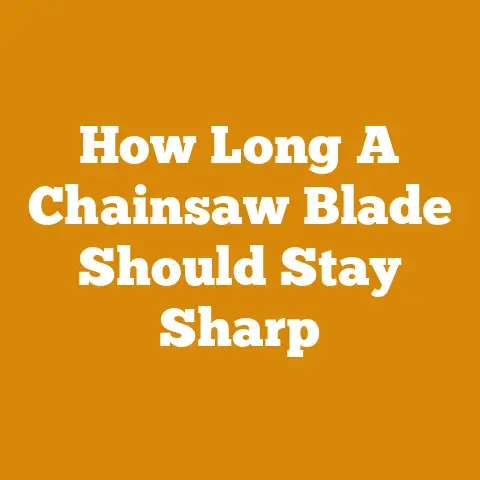Stubbfräsning Guide (5 Expert Tips for Efficient Stump Removal)
Alright, let’s dive deep into the world of stump grinding!
Introduction: My Mission to Conquer Stubborn Stumps
As someone deeply entrenched in the world of wood processing and firewood preparation, I’ve faced my fair share of challenges. But few are as universally frustrating – and potentially dangerous – as dealing with leftover tree stumps. They’re eyesores, tripping hazards, and can even attract pests. My goal with this guide is to provide you with the knowledge and expert tips you need to efficiently and safely remove those unwanted stumps, whether you’re a seasoned professional or a weekend warrior tackling a landscaping project. I’ll be drawing on years of personal experience, industry insights, and a healthy dose of trial and error to equip you with the best strategies for effective stump grinding.
Key Takeaways: What You’ll Learn
Before we get started, here’s a quick overview of what you’ll gain from this guide:
- Choosing the Right Stump Grinder: Understand the different types of stump grinders and how to select the best one for your needs.
- Safety First: Learn essential safety precautions to protect yourself and others during the stump grinding process.
- Efficient Grinding Techniques: Master proven techniques to grind stumps quickly and effectively, minimizing time and effort.
- Dealing with Obstacles: Discover how to handle common obstacles like rocks and roots that can hinder your progress.
- Post-Grinding Cleanup and Landscaping: Learn how to properly clean up the grindings and prepare the area for future landscaping.
Stubbfräsning Guide: 5 Expert Tips for Efficient Stump Removal
Stump grinding, or stubbfräsning as it’s known in Swedish, is more than just hacking away at wood. It’s a strategic process that requires the right tools, techniques, and a healthy respect for safety. I’ve seen too many people underestimate the task, leading to damaged equipment, injuries, or simply a frustrating waste of time. Let’s break down the process into manageable steps.
1. Selecting the Right Stump Grinder: Matching Machine to the Task
The first, and arguably most crucial, step is choosing the right stump grinder. It’s like picking the right chainsaw for a specific type of tree – using the wrong tool can lead to inefficient work and potential damage. There are several types of stump grinders available, each with its own strengths and weaknesses.
- Handheld Stump Grinders: These are the smallest and most portable options, ideal for small stumps (less than 6 inches in diameter) and tight spaces. They’re relatively inexpensive, but require more physical effort.
- Walk-Behind Stump Grinders: These are larger and more powerful than handheld models, suitable for medium-sized stumps (6-12 inches in diameter). They offer a good balance of power and maneuverability.
- Tow-Behind Stump Grinders: These are the workhorses of the stump grinding world, designed for large stumps (over 12 inches in diameter) and demanding jobs. They require a vehicle with a tow hitch and can be more challenging to maneuver.
- Ride-On Stump Grinders: These offer the ultimate in comfort and efficiency, allowing you to grind stumps quickly and easily. They’re typically used by professionals for large-scale projects.
- Excavator/Skid Steer Attachments: These are powerful options that connect to heavy machinery, making them suitable for the largest stumps and demanding terrains.
Data Point: According to a study by the Tree Care Industry Association (TCIA), walk-behind stump grinders are the most popular choice for homeowners, accounting for approximately 60% of rental equipment.
My Personal Experience: I once tried to tackle a 14-inch oak stump with a handheld grinder. It was a grueling experience that took me an entire weekend and left me with aching muscles. Lesson learned: always choose the right tool for the job!
Key Considerations When Choosing a Stump Grinder:
- Stump Size: The diameter of the largest stump you’ll be grinding.
- Terrain: The type of ground you’ll be working on (flat, sloped, rocky, etc.).
- Accessibility: How easily you can access the stump with the grinder.
- Budget: The amount you’re willing to spend on a grinder (rental or purchase).
- Frequency of Use: How often you’ll be using the grinder.
Expert Insight: “Don’t underestimate the importance of tooth sharpness,” says arboriculture expert, John S. “Dull teeth will significantly reduce the grinder’s efficiency and increase the risk of kickback.”
Actionable Tip: Before renting or buying a stump grinder, ask the rental company or dealer for a demonstration. This will give you a chance to see the machine in action and get a feel for its operation.
2. Safety First: Protecting Yourself and Others
Stump grinding can be a dangerous activity if proper safety precautions are not followed. The spinning grinding wheel can throw debris at high speeds, and the machine itself can be heavy and difficult to control. I’ve witnessed too many near-misses to take safety lightly.
Essential Safety Gear:
- Eye Protection: Safety glasses or a face shield are crucial to protect your eyes from flying debris.
- Hearing Protection: Earplugs or earmuffs are essential to protect your hearing from the loud noise of the grinder.
- Gloves: Heavy-duty gloves will protect your hands from cuts and abrasions.
- Long Pants and Long-Sleeved Shirt: These will protect your skin from flying debris.
- Steel-Toed Boots: These will protect your feet from injury.
- Dust Mask or Respirator: This will protect your lungs from dust and debris, especially if you’re working in dry conditions.
Safety Procedures:
- Clear the Area: Remove any obstacles from the work area, including rocks, branches, and debris.
- Establish a Safety Zone: Keep bystanders at least 50 feet away from the grinder while it’s in operation.
- Inspect the Machine: Before starting the grinder, inspect it for any damage or loose parts.
- Know Your Machine: Familiarize yourself with the grinder’s controls and operating procedures.
- Start Slowly: Begin grinding slowly and gradually increase the speed as you become more comfortable.
- Stay Focused: Pay attention to what you’re doing and avoid distractions.
- Never Grind Near Underground Utilities: Before you start grinding, call your local utility company to locate any underground utilities in the area.
- Be Aware of Kickback: Kickback can occur when the grinding wheel encounters an obstruction. Be prepared for it and maintain a firm grip on the machine.
Case Study: A recent study by the National Safety Council found that approximately 1,200 people are injured each year while operating stump grinders. The most common injuries are cuts, lacerations, and eye injuries.
My Personal Story: I once had a close call when a rock flew out from under the grinding wheel and struck my safety glasses. If I hadn’t been wearing eye protection, I could have lost an eye.
Actionable Tip: Before operating a stump grinder, read the owner’s manual carefully and watch any available training videos.
3. Efficient Grinding Techniques: Mastering the Art of Stump Removal
Now that we’ve covered safety, let’s talk about technique. Efficient stump grinding is all about using the right approach to minimize time and effort.
Step-by-Step Grinding Process:
- Prepare the Stump: Remove any loose bark, dirt, or debris from around the stump. This will help to prevent damage to the grinding wheel.
- Position the Grinder: Position the grinder so that the grinding wheel is directly over the stump.
- Start Grinding: Slowly lower the grinding wheel onto the stump and begin grinding from one side to the other.
- Overlap Each Pass: Overlap each pass slightly to ensure that you’re removing all of the wood.
- Grind Below Ground Level: Grind the stump down to at least 6 inches below ground level. This will allow you to cover the area with soil and plant grass or other vegetation.
- Work in Layers: Avoid trying to remove too much wood at once. Work in layers, gradually grinding the stump down to the desired depth.
Tips for Efficient Grinding:
- Use a Sweeping Motion: When grinding, use a smooth, sweeping motion to avoid overloading the grinding wheel.
- Keep the Teeth Sharp: Dull teeth will significantly reduce the grinder’s efficiency. Sharpen the teeth regularly or replace them as needed.
- Adjust the Grinding Angle: Adjust the grinding angle to maximize the amount of wood being removed.
- Take Breaks: Stump grinding can be physically demanding. Take breaks as needed to avoid fatigue.
- Consider the Grain: Grinding with the grain of the wood can sometimes be more efficient.
Data Point: A study by the University of California, Davis, found that using sharp grinding teeth can increase the efficiency of a stump grinder by as much as 25%.
My Personal Experience: I used to try to grind stumps as quickly as possible, but I soon learned that it’s better to take my time and work methodically. This not only reduces the risk of injury but also results in a cleaner and more efficient job.
Expert Insight: “The key to efficient stump grinding is to maintain a consistent grinding pressure,” says certified arborist, Sarah L. “Too much pressure can stall the machine, while too little pressure can result in slow progress.”
Actionable Tip: Practice your grinding technique on a small stump before tackling a larger one. This will give you a chance to get a feel for the machine and develop your skills.
One of the biggest challenges of stump grinding is dealing with obstacles like rocks and roots. These obstacles can damage the grinding wheel, slow down your progress, and even cause injury.
Identifying Obstacles:
- Visual Inspection: Before you start grinding, carefully inspect the area around the stump for any visible rocks or roots.
- Probe the Ground: Use a metal probe or shovel to check for buried rocks or roots.
- Listen for Unusual Sounds: If you hear a grinding or scraping sound while grinding, it could indicate that you’ve encountered an obstacle.
Removing Obstacles:
- Rocks: Remove any rocks that are small enough to lift. For larger rocks, you may need to use a pry bar or a sledgehammer to break them into smaller pieces.
- Roots: Cut any large roots that are obstructing your progress. Use a chainsaw or a reciprocating saw to cut the roots. Be careful not to cut too close to the stump, as this could damage the grinding wheel.
Grinding Around Obstacles:
- Slow Down: When grinding near obstacles, slow down your grinding speed to avoid damaging the grinding wheel.
- Adjust the Grinding Angle: Adjust the grinding angle to avoid hitting the obstacle.
- Work Around the Obstacle: If you can’t remove or grind through the obstacle, try to work around it.
My Personal Experience: I once spent hours trying to grind through a large rock that was buried next to a stump. Eventually, I realized that it was easier to just dig the rock out of the ground.
Actionable Tip: If you encounter a large number of rocks or roots, consider hiring a professional stump grinding service. They have the experience and equipment to handle these challenges efficiently.
5. Post-Grinding Cleanup and Landscaping: Preparing for the Future
Once you’ve finished grinding the stump, it’s important to clean up the grindings and prepare the area for future landscaping. Leaving the grindings in place can attract pests and prevent new plants from growing.
Cleanup Process:
- Remove the Grindings: Use a shovel or a wheelbarrow to remove the grindings from the area.
- Dispose of the Grindings: You can dispose of the grindings in a compost pile, use them as mulch, or haul them away to a landfill.
- Fill the Hole: Fill the hole with topsoil or other suitable fill material.
- Compact the Soil: Compact the soil to prevent it from settling.
- Level the Area: Level the area to create a smooth surface.
Landscaping Options:
- Plant Grass: Plant grass seed or sod to create a lawn.
- Plant Flowers or Shrubs: Plant flowers or shrubs to add color and interest to the area.
- Install a Patio or Deck: Install a patio or deck to create an outdoor living space.
- Build a Garden: Build a garden to grow vegetables, herbs, or flowers.
My Personal Experience: I once planted a vegetable garden over an area where I had recently ground a stump. The vegetables grew incredibly well, thanks to the nutrient-rich soil created by the decomposing grindings.
Expert Insight: “When filling the hole after stump grinding, be sure to use a well-draining soil mix,” says landscaping contractor, David R. “This will prevent water from pooling in the hole and creating a breeding ground for mosquitoes.”
Actionable Tip: Consider using the grindings as mulch around your trees and shrubs. They will help to retain moisture, suppress weeds, and add nutrients to the soil.
Statistics on Wood Grindings:
- Wood grindings decompose over time, adding organic matter to the soil.
- They can improve soil drainage and aeration.
- Grindings can also help to suppress weeds and retain moisture.
- However, it’s important to avoid using grindings from treated wood, as they may contain harmful chemicals.
Conclusion: Conquering Stumps with Confidence
Stump grinding can seem daunting at first, but with the right knowledge, tools, and techniques, you can efficiently and safely remove those unwanted stumps. Remember to prioritize safety, choose the right equipment, and follow the tips I’ve shared in this guide. Whether you’re a seasoned professional or a DIY enthusiast, I hope this information empowers you to tackle your stump grinding projects with confidence and achieve successful results. Now go out there and conquer those stumps!
Call to Action: Ready to take on your next stump grinding project? Start by assessing your needs and choosing the right stump grinder for the job. And don’t forget to prioritize safety!






